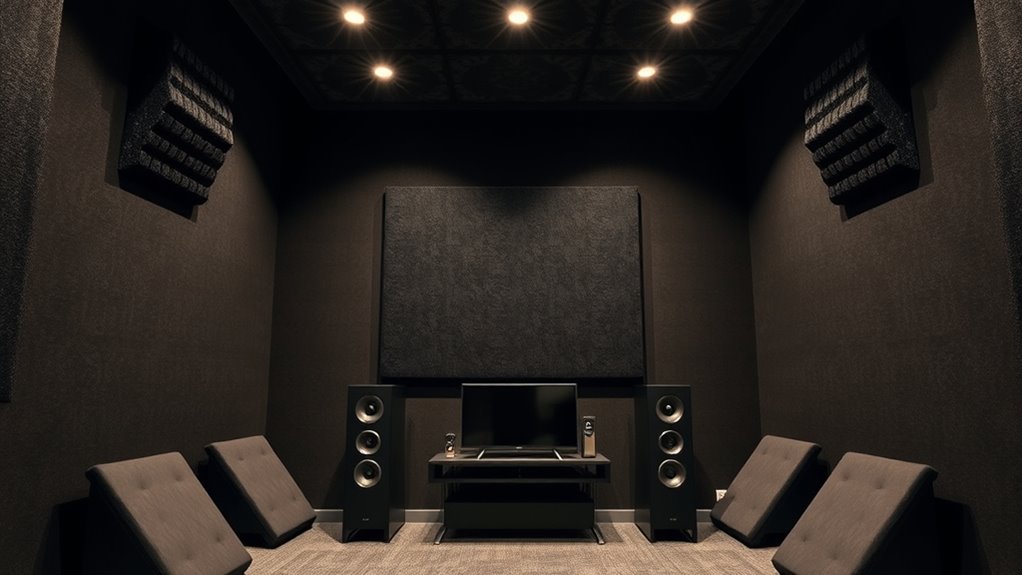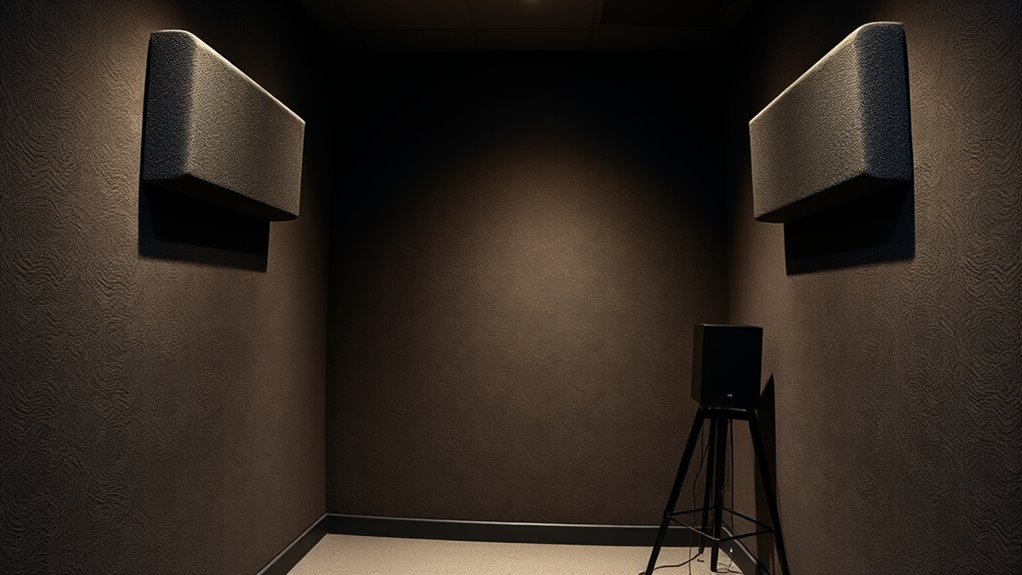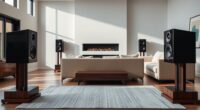For the best bass response in small rooms, place your bass traps directly into the vertical corners where low-frequency energy tends to build up. Focus on corners where walls meet each other and where walls meet the ceiling, as these areas act as pressure zones that amplify bass issues. Treating these spots first ensures you reduce muddiness and create a clearer sound. Keep exploring to discover more tips for ideal room treatment.
Key Takeaways
- Install bass traps directly into room corners, especially where two walls meet and behind furniture if accessible.
- Place traps at first reflection points on walls identified using a mirror or reflection tool.
- Prioritize corner treatment over widespread absorption to target low-frequency buildup effectively.
- Combine corner traps with reflection point treatments for balanced bass response.
- Use sound monitoring during setup to refine trap placement for optimal low-frequency absorption.

When setting up bass traps in small rooms, proper placement is essential to effectively control low-frequency resonances and improve sound clarity. In such environments, bass frequencies tend to build up in specific areas, creating muddiness and uneven sound. To combat this, your primary focus should be on installing bass traps in the room corners, where low-frequency energy naturally accumulates. These corners act as pressure zones, amplifying bass issues if left unaddressed. By placing traps directly into these corners, you absorb the excess energy before it reflects back into the room, resulting in tighter, more balanced bass response.
Additionally, wall reflection points play a pivotal role in bass management. While the corners handle the low-end buildup, you should also consider treating first reflection points on walls where sound bounces directly toward your listening position. These reflections can cause comb-filtering and muddiness, especially when combined with corner resonances. Use a mirror or a reflection tool to identify these points accurately, and install bass traps or broadband absorbers there. This process helps to reduce flutter echoes and smooth out the frequency response, making the bass sound cleaner and more natural.
In small rooms, it’s tempting to place traps everywhere, but strategic placement is more effective. Focus on the corners first, especially where two walls meet or where the ceiling meets the walls, as these are the most critical spots for low-frequency absorption. For best results, install bass traps in all the room’s vertical corners, including behind furniture or equipment if possible. You can also add trap panels along the entire length of the walls at reflection points, ensuring that sound waves don’t bounce excessively and cause phase issues. Considering the room’s acoustic properties and monitoring the sound response during setup can further optimize the placement for ideal bass control.
Frequently Asked Questions
Can Bass Traps Be Placed Behind Furniture?
Yes, you can place bass traps behind furniture, but it’s not perfect. Furniture placement can cause acoustic interference, reducing the traps’ effectiveness. When bass traps sit behind large or dense furniture, they may not absorb low frequencies properly. For best results, position bass traps in corners and along walls where they directly target bass buildup. Avoid hiding them behind furniture if you want ideal sound treatment in your small room.
How Do I Know if My Bass Traps Are Effective?
You can tell if your bass traps are effective by checking your room’s frequency response with a measurement mic or software. If low-frequency resonances are reduced and sound absorption improves, your traps are working well. You’ll notice a tighter, more balanced sound, especially in bass-heavy ranges. Regularly testing and adjusting placement ensures peak performance, giving you clearer, more accurate audio in your small room.
Should Bass Traps Be Used in Conjunction With Diffusers?
Absolutely, you should use bass traps with diffusers—they’re like peanut butter and jelly for your room’s acoustics. Not only do they boost your room aesthetics, but they also seamlessly integrate acoustic treatment, turning chaos into clarity. Think of bass traps as the foundation, and diffusers as the finishing touch. Together, they transform your space into a sonic paradise, ensuring sound quality doesn’t just look good but feels right.
What Is the Ideal Distance Between Bass Traps and Walls?
You should place bass traps about 6 to 12 inches away from room corners, where wall gaps naturally occur. This distance allows traps to effectively absorb low frequencies without causing reflections or standing waves. Keep in mind, too close and they might dampen high frequencies, too far and they won’t target the problem areas. Adjust based on your room’s specific dimensions for ideal bass management.
Can DIY Bass Traps Outperform Commercial Options?
Did you know DIY bass traps can be just as effective as commercial options if built correctly? Your DIY effectiveness depends on materials and construction, often matching or surpassing commercial performance at a lower cost. With proper design, you control density and placement, optimizing absorption. So, if you’re handy, building your own bass traps can deliver professional results, making them a smart, budget-friendly choice for your small room.
Conclusion
Think of your small room as a musical instrument, and bass traps as the tuning pegs that keep it sounding perfect. By placing them at the right spots—corners and walls—you’ll smooth out those pesky low frequencies. This setup helps your room breathe and resonate just right, turning it into a well-balanced sound sanctuary. With a little effort, you’ll create a cozy space where music and creativity can truly thrive.















